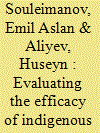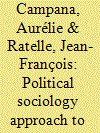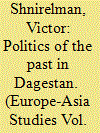| Srl | Item |
| 1 |
ID:
144773


|
|
|
|
|
| Summary/Abstract |
This study seeks to identify factors conducive to the (in)efficacy of indigenous forces (IF) in counterinsurgency (COIN) operations in Russia’s republics of Chechnya and Dagestan. Empirically, it is the first study to offer an examination of the deployment of IF in the North Caucasus-based COIN. The findings of this article emphasize that the effectiveness of COIN in Chechnya, unlike Dagestan, is conditioned by a number of factors pertaining to the structural and organizational characteristics of IF. Of these, the IF’s experience as former insurgents, their access to insider information, and their loyalty to incumbents – often maintained by the threat of collective punishment – have proven decisive for a relatively successful COIN in Chechnya.
|
|
|
|
|
|
|
|
|
|
|
|
|
|
|
|
| 2 |
ID:
116072


|
|
|
|
|
| Publication |
2012.
|
| Summary/Abstract |
This article addresses temporary labour migration - known in Russian as otkhodnichestvo (going away on foot) - from the Russian republic of Dagestan. The discussion is situated within reviews of current work on migration in the former Soviet Union, push-pull factors determining migration behaviour in the North Caucasus, and the historical importance of otkhodnichestvo in imperial Russia and the USSR. The paper then turns to the results of a census conducted in summer 2006, which found that most migrants come from Dagestan's mountainous southwest, frequently obtain work at locations characterized by economic growth and high pay, and rely on ethnic or communal networks as a basis for choosing employment sector and destination when searching for work.
|
|
|
|
|
|
|
|
|
|
|
|
|
|
|
|
| 3 |
ID:
132213


|
|
|
|
|
| Publication |
2014.
|
| Summary/Abstract |
This article seeks to foster a better understanding of the diffusion of conflict in the North Caucasus. We argue that diffusion of conflict is a dynamic and adaptive process in which outcomes are shaped by the intersection of three social mechanisms-attribution of similarity, brokerage, and outbidding-and the political, social, and religious contexts. We suggest that a distinction should be made between horizontal and vertical processes of diffusion. We also approach the empirical diffusion of conflict from a different perspective, showing that non-Chechen actors have played a key role in both the diffusion process and its outcomes.
|
|
|
|
|
|
|
|
|
|
|
|
|
|
|
|
| 4 |
ID:
160856


|
|
|
|
|
| Summary/Abstract |
Dagestan is inhabited by numerous ethnic communities with their own languages, cultures and histories. However, despite its ethnic and cultural diversity, the republic’s authorities have consistently sought to promote a unified concept of Dagestani identity. This policy has been challenged by local ethnic nationalists concerned about the future of their ethnic communities, which they saw as being endangered by assimilation and marginalisation. This struggle to secure political and social benefits began in the Soviet period and reached its height in the early 1990s. Resentment was particularly widespread among the Kumyks and Lezgins. Their dissatisfaction with the status quo resulted in a competition between inclusive (national) and exclusive (ethnic) approaches, which in turn manifested themselves in debates over historiography. This essay analyses the development and outcomes of this struggle from the 1950s through to the early 2000s, with an emphasis on the early 1990s.
|
|
|
|
|
|
|
|
|
|
|
|
|
|
|
|
| 5 |
ID:
156894


|
|
|
|
|
| Summary/Abstract |
This article posits that the remnants of archaic sociocultural norms, particularly the honour-imposed custom of retaliation, play a crucial role in the process of insurgent engagement in Russia's autonomous republic of Dagestan. Through a series of interviews with former insurgents, this study outlines two retaliation-centred mechanisms: “individual retaliation” and “spiritual retaliation” in order to explain the microcosm of motives behind insurgent activity in Dagestan. In doing so, this study problematizes the role of Salafi/Jihadist ideology as the main impetus for insurgent violence. Reversing the traditional causal link between violence and religion, this study also demonstrates that the development of Jihadist ideology is a by-product of insurgent mobilization rather than its cause.
|
|
|
|
|
|
|
|
|
|
|
|
|
|
|
|